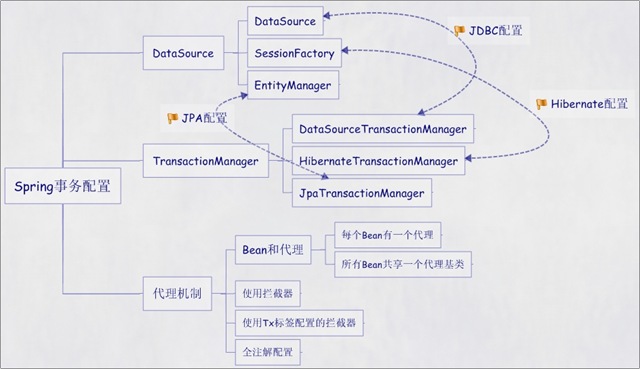Spring事物:编程式和声明式 配置文件中关于事务配置总是由三个组成部分,分别是DataSource、TransactionManager和代理机制这三部分,无论哪种配置方式,一般变化的只是代理机制这部分。
DataSource、TransactionManager这两部分只是会根据数据访问方式有所变化,比如使用Hibernate进行数据访问时,DataSource实际为SessionFactory,TransactionManager的实现为HibernateTransactionManager。
具体如下图:

根据代理机制的不同,总结了五种Spring事务的配置方式,配置文件如下:
第一种方式:每个Bean都有一个代理
<?xml version="1.0" encoding="UTF-8"?> <beans xmlns="http://www.springframework.org/schema/beans" xmlns:xsi="http://www.w3.org/2001/XMLSchema-instance" xmlns:context="http://www.springframework.org/schema/context" xmlns:aop="http://www.springframework.org/schema/aop" xsi:schemaLocation="http://www.springframework.org/schema/beans http://www.springframework.org/schema/beans/spring-beans-2.5.xsd http://www.springframework.org/schema/context http://www.springframework.org/schema/context/spring-context-2.5.xsd http://www.springframework.org/schema/aop http://www.springframework.org/schema/aop/spring-aop-2.5.xsd"> <bean id="sessionFactory" class="org.springframework.orm.hibernate3.LocalSessionFactoryBean"> <property name="configLocation" value="classpath:hibernate.cfg.xml" /> <property name="configurationClass" value="org.hibernate.cfg.AnnotationConfiguration" /> </bean> <!-- 定义事务管理器(声明式的事务) --> <bean id="transactionManager" class="org.springframework.orm.hibernate3.HibernateTransactionManager"> <property name="sessionFactory" ref="sessionFactory" /> </bean> <!-- 配置DAO --> <bean id="userDaoTarget" class="com.bluesky.spring.dao.UserDaoImpl"> <property name="sessionFactory" ref="sessionFactory" /> </bean> <bean id="userDao" class="org.springframework.transaction.interceptor.TransactionProxyFactoryBean"> <!-- 配置事务管理器 --> <property name="transactionManager" ref="transactionManager" /> <property name="target" ref="userDaoTarget" /> <property name="proxyInterfaces" value="com.sprinng.spring.dao.GeneratorDao" /> <!-- 配置事务属性 --> <property name="transactionAttributes"> <props> <prop key="*">PROPAGATION_REQUIRED</prop> </props> </property> </bean> </beans>
第二种方式:所有Bean共享一个代理基类
<?xml version="1.0" encoding="UTF-8"?> <beans xmlns="http://www.springframework.org/schema/beans" xmlns:xsi="http://www.w3.org/2001/XMLSchema-instance" xmlns:context="http://www.springframework.org/schema/context" xmlns:aop="http://www.springframework.org/schema/aop" xsi:schemaLocation="http://www.springframework.org/schema/beans http://www.springframework.org/schema/beans/spring-beans-2.5.xsd http://www.springframework.org/schema/context http://www.springframework.org/schema/context/spring-context-2.5.xsd http://www.springframework.org/schema/aop http://www.springframework.org/schema/aop/spring-aop-2.5.xsd"> <bean id="sessionFactory" class="org.springframework.orm.hibernate3.LocalSessionFactoryBean"> <property name="configLocation" value="classpath:hibernate.cfg.xml" /> <property name="configurationClass" value="org.hibernate.cfg.AnnotationConfiguration" /> </bean> <!-- 定义事务管理器(声明式的事务) --> <bean id="transactionManager" class="org.springframework.orm.hibernate3.HibernateTransactionManager"> <property name="sessionFactory" ref="sessionFactory" /> </bean> <bean id="transactionBase" class="org.springframework.transaction.interceptor.TransactionProxyFactoryBean" lazy-init="true" abstract="true"> <!-- 配置事务管理器 --> <property name="transactionManager" ref="transactionManager" /> <!-- 配置事务属性 --> <property name="transactionAttributes"> <props> <prop key="*">PROPAGATION_REQUIRED</prop> </props> </property> </bean> <!-- 配置DAO --> <bean id="userDaoTarget" class="com.sprinng.spring.dao.UserDaoImpl"> <property name="sessionFactory" ref="sessionFactory" /> </bean> <bean id="userDao" parent="transactionBase" > <property name="target" ref="userDaoTarget" /> </bean> </beans>
第三种方式:使用拦截器
<?xml version="1.0" encoding="UTF-8"?> <beans xmlns="http://www.springframework.org/schema/beans" xmlns:xsi="http://www.w3.org/2001/XMLSchema-instance" xmlns:context="http://www.springframework.org/schema/context" xmlns:aop="http://www.springframework.org/schema/aop" xsi:schemaLocation="http://www.springframework.org/schema/beans http://www.springframework.org/schema/beans/spring-beans-2.5.xsd http://www.springframework.org/schema/context http://www.springframework.org/schema/context/spring-context-2.5.xsd http://www.springframework.org/schema/aop http://www.springframework.org/schema/aop/spring-aop-2.5.xsd"> <bean id="sessionFactory" class="org.springframework.orm.hibernate3.LocalSessionFactoryBean"> <property name="configLocation" value="classpath:hibernate.cfg.xml" /> <property name="configurationClass" value="org.hibernate.cfg.AnnotationConfiguration" /> </bean> <!-- 定义事务管理器(声明式的事务) --> <bean id="transactionManager" class="org.springframework.orm.hibernate3.HibernateTransactionManager"> <property name="sessionFactory" ref="sessionFactory" /> </bean> <bean id="transactionInterceptor" class="org.springframework.transaction.interceptor.TransactionInterceptor"> <property name="transactionManager" ref="transactionManager" /> <!-- 配置事务属性 --> <property name="transactionAttributes"> <props> <prop key="*">PROPAGATION_REQUIRED</prop> </props> </property> </bean> <bean class="org.springframework.aop.framework.autoproxy.BeanNameAutoProxyCreator"> <property name="beanNames"> <list> <value>*Dao</value> </list> </property><!--也可以用注解替代上面的beanNames 记得别忘了 <tx:annotation-driven transaction-manager="transactionManager"/>参考第五种 --> <property name="interceptorNames"> <list> <value>transactionInterceptor</value> </list> </property> </bean> <!-- 配置DAO --> <bean id="userDao" class="com.sprinng.spring.dao.UserDaoImpl"> <property name="sessionFactory" ref="sessionFactory" /> </bean> </beans>
第四种方式:使用tx标签配置的拦截器
<?xml version="1.0" encoding="UTF-8"?> <beans xmlns="http://www.springframework.org/schema/beans" xmlns:xsi="http://www.w3.org/2001/XMLSchema-instance" xmlns:context="http://www.springframework.org/schema/context" xmlns:aop="http://www.springframework.org/schema/aop" xmlns:tx="http://www.springframework.org/schema/tx" xsi:schemaLocation="http://www.springframework.org/schema/beans http://www.springframework.org/schema/beans/spring-beans-2.5.xsd http://www.springframework.org/schema/context http://www.springframework.org/schema/context/spring-context-2.5.xsd http://www.springframework.org/schema/aop http://www.springframework.org/schema/aop/spring-aop-2.5.xsd http://www.springframework.org/schema/tx http://www.springframework.org/schema/tx/spring-tx-2.5.xsd"> <context:annotation-config /> <context:component-scan base-package="com.sprinng" /> <bean id="sessionFactory" class="org.springframework.orm.hibernate3.LocalSessionFactoryBean"> <property name="configLocation" value="classpath:hibernate.cfg.xml" /> <property name="configurationClass" value="org.hibernate.cfg.AnnotationConfiguration" /> </bean> <!-- 定义事务管理器(声明式的事务) --> <bean id="transactionManager" class="org.springframework.orm.hibernate3.HibernateTransactionManager"> <property name="sessionFactory" ref="sessionFactory" /> </bean> <tx:advice id="txAdvice" transaction-manager="transactionManager"> <tx:attributes> <tx:method name="*" propagation="REQUIRED" /> </tx:attributes> </tx:advice> <aop:config> <aop:pointcut id="interceptorPointCuts" expression="execution(* com.sprinng.spring.dao.*.*(..))" /> <aop:advisor advice-ref="txAdvice" pointcut-ref="interceptorPointCuts" /> </aop:config> </beans>
第五种方式:全注解
<?xml version="1.0" encoding="UTF-8"?> <beans xmlns="http://www.springframework.org/schema/beans" xmlns:xsi="http://www.w3.org/2001/XMLSchema-instance" xmlns:context="http://www.springframework.org/schema/context" xmlns:aop="http://www.springframework.org/schema/aop" xmlns:tx="http://www.springframework.org/schema/tx" xsi:schemaLocation="http://www.springframework.org/schema/beans http://www.springframework.org/schema/beans/spring-beans-2.5.xsd http://www.springframework.org/schema/context http://www.springframework.org/schema/context/spring-context-2.5.xsd http://www.springframework.org/schema/aop http://www.springframework.org/schema/aop/spring-aop-2.5.xsd http://www.springframework.org/schema/tx http://www.springframework.org/schema/tx/spring-tx-2.5.xsd"> <context:annotation-config /> <context:component-scan base-package="com.sprinng" /> <!-- transaction-manager:指定事务管理器名字,默认为transactionManager,当使用其他名字时需要明确指定:proxy-target-class:默认false表示使用JDK代理,如果为true将使用CGLIB代理 --> <tx:annotation-driven transaction-manager="transactionManager"/> <bean id="sessionFactory" class="org.springframework.orm.hibernate3.LocalSessionFactoryBean"> <property name="configLocation" value="classpath:hibernate.cfg.xml" /> <property name="configurationClass" value="org.hibernate.cfg.AnnotationConfiguration" /> </bean> <!-- 定义事务管理器(声明式的事务) --> <bean id="transactionManager" class="org.springframework.orm.hibernate3.HibernateTransactionManager"> <property name="sessionFactory" ref="sessionFactory" /> </bean> <bean id="dataSource" class="org.apache.commons.dbcp2.BasicDataSource" destroy-method="close"> <property name="driverClassName" value="com.mysql.jdbc.Driver"/> <property name="url" value="jdbc:mysql://localhost:3306/db?characterEncoding=utf8"/> <!--要设置dataSource 的自动提交为false,让spring 去管理提交,自动提交默认是true --> <property name="defaultAutoCommit" value="false"/> </bean> </beans>
如果要想所有异常都回滚,要加上属性rollbackFor={Exception.class}
@Transactional(readOnly=false, rollbackFor=Exception.class) public boolean postData(BC021Bean activity) throws Exception { Gson gson = new Gson();
//注意@Transactional只能被应用到public方法上,对于其它非public的方法,如果标记了@Transactional也不会报错,但方法没有事务功能。
了解事务的集中传播特性 1、PROPAGATION_REQUIRED:如果存在一个事务,则支持当前事务。如果没有事务则开启。 2、PROPAGATION_SUPPORTS:如果存在一个事务,支持当前事务。如果没有事务,则非事务的执行。 3、PROPAGATION_MANDATORY:如果已经存在一个事务,支持当前事务。如果没有一个活动的事务,则抛出异常。 4、PROPAGATION_REQUIRES_NEW:总是开启一个新的事务。如果一个事务存在,则将这个存在的事务挂起。 5、PROPAGATION_NOT_SUPPORTED:总是非事务地执行,并挂起任何存在的事务。 6、PROPAGATION_NEVER:总是非事务地执行,如果存在一个活动事务,则抛出异常。 7、 PROPAGATION_NESTED:如果一个活动的事务存在,则运行在一个嵌套的事务中,如果没有活动事务,则按TransactionDefinition.PROPAGATION_REQUIRED属性执行 Spring事务的隔离级别 1、 ISOLATION_DEFAULT: 这是一个PlatfromTransactionManager默认的隔离级别,使用数据库默认的事务隔离级别。 2、ISOLATION_READ_UNCOMMITTED:这是事务最低的隔离级别,它允许另外一个事务可以看到这个事务未提交的数据。 3、ISOLATION_READ_COMMITTED:保证一个事务修改的数据提交后才能被另外一个事务读取。另外一个事务不能读取该事务未提交的数据。 4、ISOLATION_REPEATALBE_READ: 这种事务隔离级别可以防止脏读,不可重复读。但是可能出现幻想读。它除了保证一个事务不能读取另外一个事务未提交的数据外,还保证了避免下面的情况产生(不可重复读)。 5、ISOLATION_SERIALIZABLE 这是花费最高代价但是最可靠的事务隔离级别。事务被处理为顺序执行。除了防止脏读,不课重复读外,还避免了幻想读。